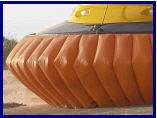What types of skirts and fans are there?
Fans and PropellersThere are two methods of providing thrust, ie a ducted fan, or a propeller. The choice of fan or propeller is largely a matter of opinion. However, size is important. Do not consider a fan of less than 900mm, with 1100mm fast becoming the preferred size. This is because the larger fan or prop will be quieter and produce more thrust – a win-win situation.
Skirt typesThere are two main skirt types, ie segmented and bag, but there are many variations and hybrids. Both types are successful in cruisers, so it seems to come down to personal choice in the end.
Segment skirts
This type of skirt consists of many individual segments, often 70 or more to make the complete skirt. Usually the segments will be the same around the front and sides of the craft, and different at the rear, although there could be up 5 types around the craft.
The advantage of the segment skirt is that is that they are damage tolerant - should a segment be damaged, the neighbouring segments expand to fill the space, and in any case it is easy to change a damaged segment in the field. The downside is that the segments frequently catch on debris and a partly pulled off, requiring re-attachment in the field, needing almost constant attention.
The segment skirt can often be fitted with an anti-plough divider curtain, and this is a distinct advantage. They do have very low roll stability, which is why a segment skirted craft will always seat the passengers on the craft centerline.
Bag skirts
There are a range of types of bag skirt, but all share a similar bag-like appearance. The skirt can be thought of as a large inner-tube that is formed around into the shape of the craft.
Bag skirts are cheaper and quicker to make and replace, and can be reliable, as there are less ‘edges’ to snag on obstacles. Minor damage can be tolerated, and field repair is easy if needed taking just a few minutes. Some say that bag skirt “grab” on dry mud – they may, but then so will any skirt.

Low pressure bag skirts such as the Sevtec, behave quite differently to high pressure bag skirts. A low pressure bag skirt (also called ‘responsive’) is capable of moulding itself to the terrain or water better than a high pressure skirt, and amongst other things this means that the skirt provides predictably low hump drag. This is contrasted to segmented skirts, which have a propensity to ‘scoop’, which can be an issue for hump performance.
The low pressure responsive 'Sev' skirt has very good roll stability, meaning that the passengers can be seated side-by-side. They are fitted with divider skirts which provide excellent pitch stability, eliminating plough-in.
Bag or loop and segment skirt
This is a hybrid, designed to have the best of both worlds. A bag skirt is mounted to the craft, and a set of segments are attached to the bottom of the bag. This is the most expensive type of skirt, and is found on all large craft but few small craft.
Skirt partitionsA partitioned skirt has one or more skirt dividers that run underneath the craft. These divide the cushion into compartments, usually front and rear, or front, rear and sides.
Large craft rely on a compartmented cushion (or skirt shift mechanisms) to provide stability, in a small craft with a single compartment, the driver must frequently shift body-weight in order to provide the required stability.
A compartmented skirt is very effective for controlling plough-in and properly designed means the craft will trim up properly regardless of the forward/aft weight distribution of the craft.
Some compartmented skirts are fitted with controllable vents, which allow the driver to control the craft attitude. This is used to provide a braking affect and permits enhanced manoeuvrability in larger craft.
Back